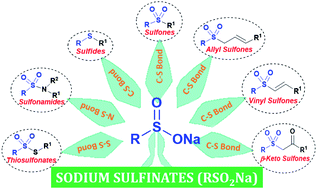Synthesis and applications of sodium sulfinates (RSO2Na): a powerful building block for the synthesis of organosulfur compounds
Abstract
This review highlights the preparation of sodium sulfinates (RSO2Na) and their multifaceted synthetic applications. Substantial progress has been made over the last decade in the utilization of sodium sulfinates emerging as sulfonylating, sulfenylating or sulfinylating reagents, depending on reaction conditions. Sodium sulfinates act as versatile building blocks for preparing many valuable organosulfur compounds through S–S, N–S, and C–S bond-forming reactions. Remarkable advancement has been made in synthesizing thiosulfonates, sulfonamides, sulfides, and sulfones, including vinyl sulfones, allyl sulfones, and β-keto sulfones. The significant achievement of developing sulfonyl radical-triggered ring-closing sulfonylation and multicomponent reactions is also thoroughly discussed. Of note, the most promising site-selective C–H sulfonylation, photoredox catalytic transformations and electrochemical synthesis of sodium sulfinates are also demonstrated. Holistically, this review provides a unique and comprehensive overview of sodium sulfinates, which summarizes 355 core references up to March 2020. The chemistry of sodium sulfinate salts is divided into several sections based on the classes of sulfur-containing compounds with some critical mechanistic insights that are also disclosed.

- This article is part of the themed collection: 2021 Reviews in RSC Advances


 Please wait while we load your content...
Please wait while we load your content...